Below is a list of defects typically found in residential construction and a brief desciption of how we investigate a particular defect.
| Windows | |
|
Defects associated with windows most often have to do with leaks, which can be a result of poor installation. This means the windows were not flashed properly, or the window product itself is defective and leaking. In many homes windows are difficult to operate. This can be a sign of soil settlement, structural deficiencies or just a bad product. We investigate the windows by performing several different tests to determine whether or not a particular window is leaking. If it leaks, we then remove a small area of stucco or siding to better understand the cause of the leak. |
 |
| Roofs | |
|
The most common defects associated with roofs generally have to do with the installation of the component parts and not the roofing material itself. As an example, we generally find roof shingles overextended or underlayment, which is short, torn, or just plain missing all of which cause leaks. Also, improper slope on a flat roof is almost always an issue. Another issue is flashing, which is the metal that helps transition one material to another such as from stucco to the roof. Many times the flashing is lapped incorrectly or improperly installed which again will cause leaks. Another common issue is ventilation, often times roofs have either inadequate ventilation or none at all. This can result in condensation issues and the appearance of leak. In order to investigate a roof, we simply remove the roofing material in a few areas to understand the way in which the roof was installed. |
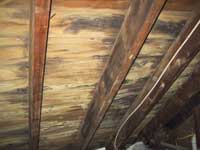 |
| Stucco | |
|
The defects associated with stucco are usually excessive cracking and flaking of the finish coat. Cracking of stucco can be caused by a number of issues. Structural deficiencies are one of the leading causes. Structural components such as a shear walls (plywood wall) are either missing or improperly installed causing the stucco to bear a load that it wasn't designed to bear. Soil settlement can cause stucco cracks as well. This is where improper compaction of the lot or where there are expansive soils present (soils that expand when exposed to moisture). Another cause is stucco shrinkage. This is where the stucco was mixed improperly or applied in severe weather conditions such as on a day when it was 20 degrees. We will typically remove areas of stucco to investigate the causes. |
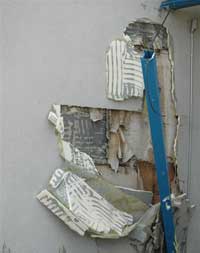 |
| Mold | |
|
Experts will tell you that mold can be present in as little as 24 hours after the initial water intrusion. Once discovered, mold infestation should be remediated immediately in an effort to minimize the possibility of health issues. Once we discover substantial mold, the area is isolated and an air sample testing is conducted. Then we document the type of mold, which is present in the area. Once we have documented the condition, the homeowner may then proceed with remediation. |
 |
| Floor Moisture Barrier | |
|
This is a relatively common complaint. Usually, we find that the concrete was not properly mixed and or the vapor barrier below the concrete is incomplete, pierced by a penetration or in some cases missing. Typically, we core at the affected areas to document the cause. |
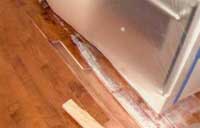 |
| Shower Enclosures | |
|
The installation of a shower enclosure can be difficult. Most of the cases we have handled involve this issue in some form and usually stem from a poor or improper installation of flashing, waterproofing or tile installation. Many times a homeowner has no idea their shower enclosure is leaking until we examine it. When we open a small area behind the enclosure we find staining and at times mold. The shower doors also become an issue. Lack of caulking often causes leaks. |
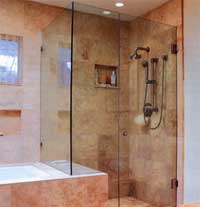 |
| Structural Issues | |
|
The framer is charged with installing the structural components of any structure. The components range from hold downs (metal straps or brackets that tie the concrete to the framing) to shear walls (plywood walls that bear lateral forces). The structural plans set out exactly where these components are, so investigating these defects is usually relatively simple. |
|
| Balconies and Decks | |
|
Balconies and decks have many of the same problems as roofs. Usually, there are installation problems involving the underlayment and flashing. Ponding of water on the decks is also an issue. Ponding will cause the premature deterioration of the deck surface. We typically remove small areas of the deck to understand the way in which it was installed. |
|
| Sliding Glass Doors | |
|
Sliding Glass Door defects are very similar to what we find with window defects. They either leak because they were installed improperly or the door itself is defective. We perform some of the same tests we perform on windows to determine the cause. |
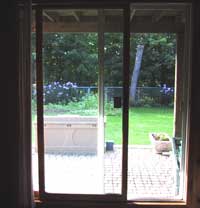 |
| French Doors | |
|
French Doors most often leak at the threshold, which is the component you step on as you walk through the door. It's relatively difficult to flash a threshold properly and very often they leak. We test the door similar to how we test windows: by spraying the door with a spray rack to simulate rain. If water enters the home, the stucco or siding is removed and the area is investigated for a cause. |
|
| Soil Settlement | |
|
Soil issues usually fall into a couple of categories. The settlement of homes and buildings is usually caused by improper compaction of the soil or the structure is placed upon expansive soils. Expansive soils expand when exposed to moisture. This causes the soil to heave and the structure to move or deflect. Simple soils tests can determine the state of the soil. Our experts usually design a repair, which resolves the problem. Every now and then, we see a home where there is high ground water or even subsurface streams, which run underneath the home. This too can be remedied through proper redesign and remediation of the defective condition. |
|
| Concrete | |
|
The most common defects with concrete are cracking and improper slope, which means when it rains the water drains toward the house instead of away from the structure. Our experts document the conditions and propose repairs. |
 |
| Drainage | |
|
This issue usually has to do with ponding in yards or water draining toward the house instead of being carried away from the structure. |
|
| Drywall | |
|
Cracks are what typically manifest as a result of drywall defects. They can be caused by the same defects that cause stucco cracks. (See stucco above, i.e. soil settlement, structural issues, and poor installation) |
|
| Fit and Finish | |
|
Any time we investigate a home or condominium for construction defects, we always look at areas such as the cabinets, tile, finish carpentry, carpet, paint, as well as the 'fit and finish' items. |
|
